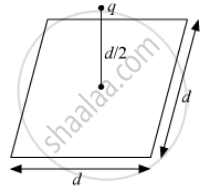Advertisements
Advertisements
प्रश्न
A point charge causes an electric flux of −1.0 × 103 Nm2/C to pass through a spherical Gaussian surface of 10.0 cm radius centred on the charge.
- If the radius of the Gaussian surface were doubled, how much flux would pass through the surface?
- What is the value of the point charge?
उत्तर
- The electric flux passing through a spherical Gaussian surface drawn around a point charge does not depend on its radius, so even if the radius is doubled, the electric flux passing through it will remain -1.0 × 108 newton-m2/coulomb.
- Φ = `q/ε_0`
or q = Φ ε0
or q = -1 × 103 × 8.85 × 10-12
or q = -8.85 × 10-9 C
= -8.85 nC
APPEARS IN
संबंधित प्रश्न
A 36 cm long sonometer wire vibrates with frequency of 280 Hz in fundamental mode, when it is under tension of 24.5 N. Calculate linear density of the material of wire.
Explain why, for a charge configuration, the equipotential surface through a point is normal to the electric field at that point
A point charge of 2.0 μC is at the centre of a cubic Gaussian surface 9.0 cm on edge. What is the net electric flux through the surface?
Obtain the formula for the electric field due to a long thin wire of uniform linear charge density λ without using Gauss’s law. [Hint: Use Coulomb’s law directly and evaluate the necessary integral.]
A point charge q is at a distance of d/2 directly above the centre of a square of side d, as shown the figure. Use Gauss' law to obtain the expression for the electric flux through the square.

If the point charge is now moved to a distance 'd' from the centre of the square and the side of the square is doubled, explain how the electric flux will be affected.
Draw a graph to show the variation of E with perpendicular distance r from the line of charge.
Find the work done in bringing a charge q from perpendicular distance r1 to r2 (r2 > r1)
A closed surface in vacuum encloses charges –q and +3q. The total electric flux emerging out of the surface is :
State Gauss’Law.
A spherical ball contracts in volume by 0.02% when subjected to a pressure of 100 atmosphere. Assuming one atmosphere = 105 Nm−2, the bulk modulus of the material of the ball is:
Through two parallel wires A and B, 10A and 2A of currents are passed respectively in opposite directions. If the wire A is infinitely long and the length of the wire B is 2m, then force on the conductor B, which is situated at 10 cm distance from A, will be:
If the ratio of radii of two wires of same material is 3 : 1 and ratio of their lengths is 5 : 1, then the ratio of the normal forces that will produce the same extension in the length of two wires is:
The electric field inside a spherical shell of uniform surface charge density is ______.
What is the nature of the Gaussian surface involved in the Gauss law of electrostatics?
An infinitely long positively charged straight wire has a linear charge density λ. An electron is revolving in a circle with a constant speed v such that the wire passes through the centre, and is perpendicular to the plane, of the circle. Find the kinetic energy of the electron in terms of the magnitudes of its charge and linear charge density λ on the wire.
Draw a graph of kinetic energy as a function of linear charge density λ.
